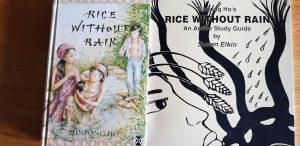About 25 years ago, I hooked up with some teachers in Singapore who also ran a publishing company. At this distance I simply can’t remember how it came about. They wanted a study text written at about age 11-13 level relating to a young adult novel called Rice Without Rain by Minfong Ho (1986) whose work was then new to me but was widely taught in Singapore.
I came up with the idea of using my study guide as a way of gently educating the student in “lit crit” technique or topic by applying a concept such as narrative point of view, symbolism, diction and the like to each of the fifteen chapters. I wrote a similar one on The Pearl by John Steinbeck. I still think it’s a good idea. If any publishers out there would like me to do more you know where I am. Read the book, study my guide and you’ll have a “toolkit” you can use to study any other novel.

Anyway, Minfong Ho was born in Myanmar (then Burma) in 1951, grew up in Bangkok and now lives in America. Like Rice Without Rain most of her books focus on poverty in South East Asia.
Rice Without Rain is set in Thailand during the student riots of the 1970s and it’s warmly readable. Jinda lives in a remote village, where drought has – again – ruined the rice harvest on which everyone depends. Because the villages don’t own their land they are required to give fifty per cent of their harvest to the landlord as rent. That is the situation when some well-meaning students from Bangkok arrive and sow disquiet by suggesting that a much lower percentage would be fairer. Meanwhile Jinda’s older sister Dao (effectively abandoned by her husband) has a baby, Oi, who is dying of malnutrition.
It’s a well plotted tale with lots of strands. Jinda’s widowed father, Inthorn the village chief, is badly injured in a farming accident and is, later, arrested. Dao and Jinda are both healthy young women. Dao gets into a toxic relationship with the man who represents the landlord and Jinda is gradually forming an attachment to one of the students. The strong, feisty grandmother is a lovely bit of characterisation. So is her little brother, Pinit. There is a lot of tension between the old ways and the new – symbolised by, for instance, the different approaches to treating Inthorn’s damaged hand. Jinda’s stay in Bangkok highlights this in other ways and we get a first hand account of the riots.
I was surprised when I first read it and still am now, that Minfong Ho’s work (The Clay Marble is a good read too) has never caught on much in Britain and particularly in British schools. It is after all an “other cultures” novel and curriculum devisers have been keenly including these for a long time now. And yet the copy I have is published (1989) in the Hienmann New Windmills Series – erstwhile backbone of English department stock cupboards in British secondary schools – so there must have been an expectation that it would be used, read and taught.
I enjoyed rereading this quite gritty novel very much – not least for its forward looking ending which focuses on new beginnings, fresh life and future possibilities rather than anything slushily traditional.
I have some copies of my study guide if anyone wants one – £5 plus p&p. Contact me.
Next week on Susan’s Bookshelves: The Quiet American by Graham Greene